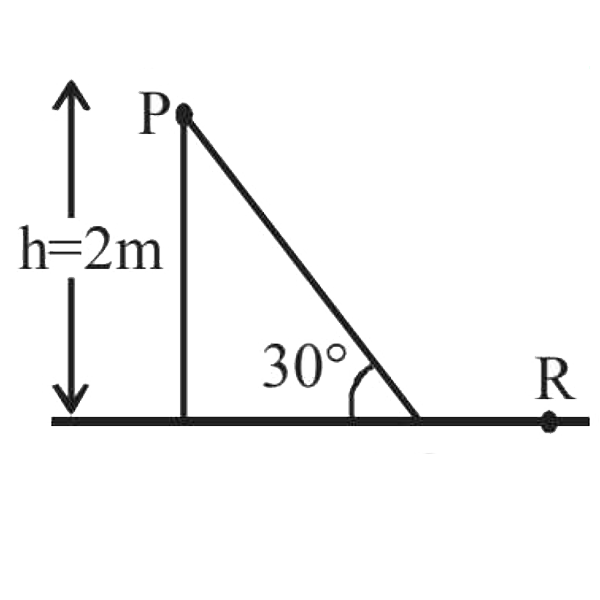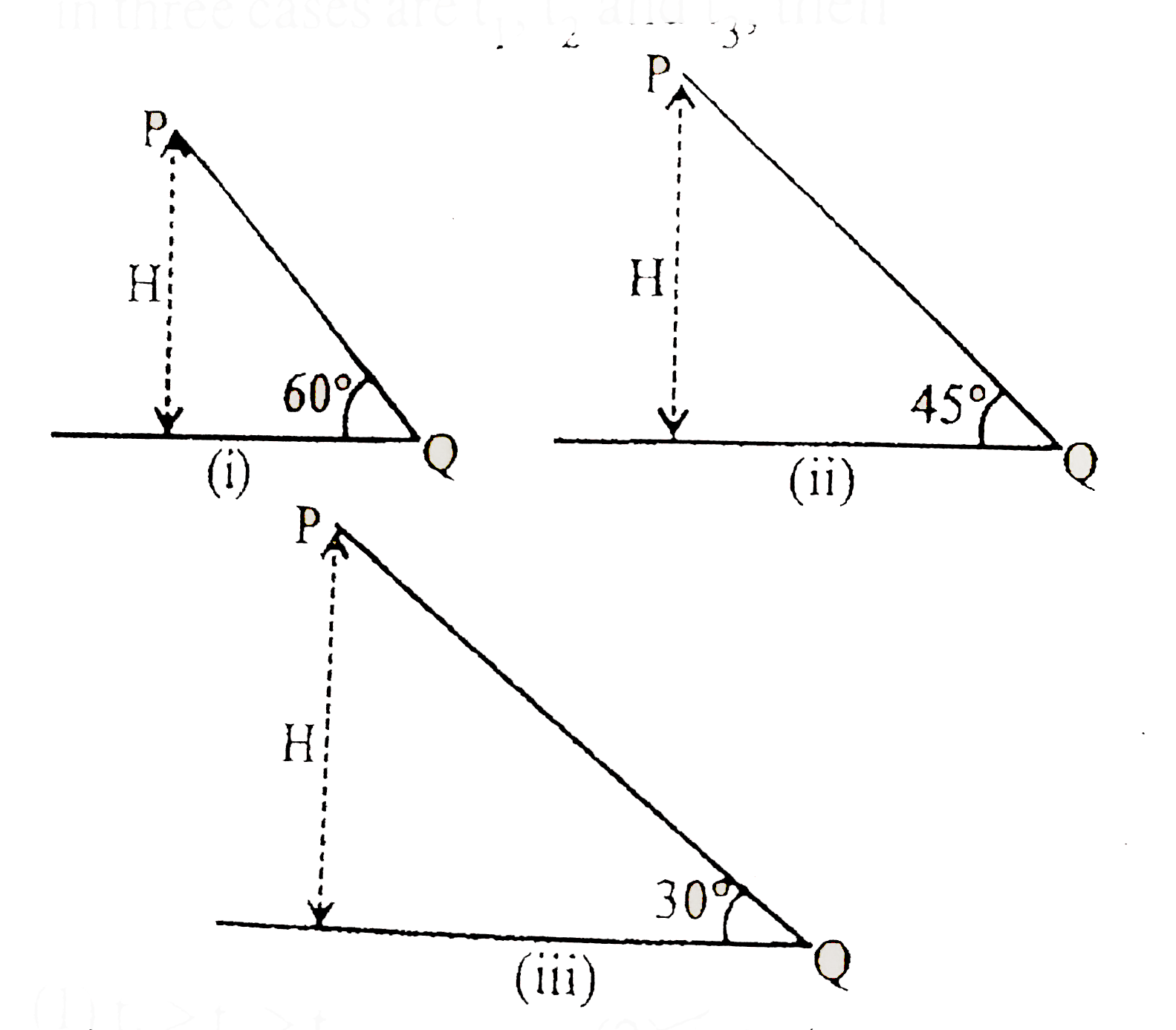P,Q,R and S are the points in a vertical line. It is given that PQ=QR=RS. A particle is released from rest from the point P. particle takes time tPQ,tQR and tRS to cover three equal distance, respectively. Find ratio tPQ:tQR:tRS
To solve the problem, we need to find the ratio of the times taken by a particle to cover three equal distances (PQ, QR, and RS) when released from rest. Let's denote the distance between each pair of points (PQ, QR, RS) as x.
1. Understanding the Motion:
The particle is released from rest, which means its initial velocity u=0. The distance covered in each segment is equal, PQ=QR=RS=x.
2. Using the Equation of Motion:
The equation of motion for an object under free fall (with acceleration due to gravity g) is given by:
s=ut+12gt2
Since u=0, this simplifies to:
s=12gt2
3. Finding Time for Each Segment:
- For the first segment PQ:
x=12gt2PQ
Rearranging gives:
t2PQ=2xg⇒tPQ=√2xg
- For the second segment QR:
The total distance covered from P to R is 2x. The time taken is tPQ+tQR:
2x=12g(tPQ+tQR)2
Expanding this gives:
2x=12g(t2PQ+2tPQtQR+t2QR)
Substituting t2PQ=2xg:
2x=12g(2xg+2tPQtQR+t2QR)
Simplifying gives:
4x=2x+2gtPQtQR+gt2QR
Rearranging leads to:
2x=2gtPQtQR+gt2QR
Dividing through by g:
2xg=2tPQtQR+t2QR
This is a quadratic equation in tQR.
- For the third segment RS:
The total distance covered from P to S is 3x:
3x=12g(tPQ+tQR+tRS)2
Following similar steps as above will yield tRS.
4. Finding the Ratios:
After calculating tPQ,tQR, and tRS, we can express them in terms of √2xg and find the ratio:
tPQ:tQR:tRS=1:(√2−1):(√3−√2)
Final Ratio:
Thus, the final ratio of the times taken is:
tPQ:tQR:tRS=1:(√2−1):(√3−√2)
The particle is released from rest, which means its initial velocity u=0. The distance covered in each segment is equal, PQ=QR=RS=x.
The equation of motion for an object under free fall (with acceleration due to gravity g) is given by:
s=ut+12gt2
Since u=0, this simplifies to:
s=12gt2
- For the first segment PQ:
x=12gt2PQ
Rearranging gives:
t2PQ=2xg⇒tPQ=√2xg
The total distance covered from P to R is 2x. The time taken is tPQ+tQR:
2x=12g(tPQ+tQR)2
Expanding this gives:
2x=12g(t2PQ+2tPQtQR+t2QR)
Substituting t2PQ=2xg:
2x=12g(2xg+2tPQtQR+t2QR)
Simplifying gives:
4x=2x+2gtPQtQR+gt2QR
Rearranging leads to:
2x=2gtPQtQR+gt2QR
Dividing through by g:
2xg=2tPQtQR+t2QR
This is a quadratic equation in tQR.
The total distance covered from P to S is 3x:
3x=12g(tPQ+tQR+tRS)2
Following similar steps as above will yield tRS.
After calculating tPQ,tQR, and tRS, we can express them in terms of √2xg and find the ratio:
tPQ:tQR:tRS=1:(√2−1):(√3−√2)
Thus, the final ratio of the times taken is:
tPQ:tQR:tRS=1:(√2−1):(√3−√2)
Topper's Solved these Questions
- MOTION IN A STRAIGHT LINE BOOK - MODERN PUBLICATIONCHAPTER - MOTION IN A STRAIGHT LINE EXERCISE - REVISION EXERCISE (VERY SHORT ANSWER QUESTION)
40 Videos
- MOTION IN A STRAIGHT LINE BOOK - MODERN PUBLICATIONCHAPTER - MOTION IN A STRAIGHT LINE EXERCISE - REVISION EXERCISE (FILL IN THE BLANKS)
10 Videos
- MOTION IN A STRAIGHT LINE BOOK - MODERN PUBLICATIONCHAPTER - MOTION IN A STRAIGHT LINE EXERCISE - NCERT (MULTIPLE CHOICE QUESTION (TYPE-II))
5 Videos
- MOTION IN A PLANE BOOK - MODERN PUBLICATIONCHAPTER - MOTION IN A PLANE EXERCISE - Chapter Practice Test
15 Videos
- OSCILLATIONS BOOK - MODERN PUBLICATIONCHAPTER - OSCILLATIONS EXERCISE - Practice Test (For Board Examination)
12 Videos
Similar Questions
Let A, B and C be points in a vertical line at height h, 4h5andh5 and from the ground. A particle released from rest from the point A reaches the ground in time T. The time taken by the particle to go from B to C is TBC . Then T(TBC)2=
View SolutionP(-3, 7) and Q(1, 9) are two points. Find the point R on PQ such that PR:QR=1:1.
View Solution
Knowledge Check
A particle is released from rest from a tower of height 3h. The ratio of time intervals for fall of equal height h i.e. t1:t2:t3 is :
A√3:√2:1B3:2:1C9:4:1D1:(√2−1):(√3−√2)A point particle of mass m, moves long the uniformly rough track PQR as shown in figure. The coefficient of friction, between the particle and the rough track equals μ. The particle is released, from rest from the point P and it comes to rest at a point R. The energies, lost by the ball, over the parts, PQ and QR, of the track, are equal to each other, and no energy is lost when particle changes direction from PQ to QR.
The value of the coefficient of friction μ and the distance x (=QR), are, respectively close to:
 A(a) 0.29 and 3.5mB(b) 0.29 and 6.5mC(c) 0.2 and 6.5mD(d) 0.2 and 3.5m
A(a) 0.29 and 3.5mB(b) 0.29 and 6.5mC(c) 0.2 and 6.5mD(d) 0.2 and 3.5mA particle starts from rest from point P and follow a path PQ on the three smooth surfaces as shown in figures. If time taken by the particle in three cases are t1,t2 and t3 then
 At1>t2>t3Bt3>t2>t1Ct3>t1>t3Dt1=t2=t3
At1>t2>t3Bt3>t2>t1Ct3>t1>t3Dt1=t2=t3
Points P,Q and R are in vertical line such that PQ=QR. A ball at (P) is allowed to fall freely. What is the ratio of the times of descent through PQ and QR ?
View SolutionQ,R and S are the points on line joining the points P(a,x) and T(b,y) such that PQ=QR=RS=ST then (5a+3b8,5x+3y8) is the mid point of
View SolutionIf P,Q and R are three collinear points such that →PQ=→a and →QR = →b. Find the vector →PR .
View SolutionS and T are points on sides PR and QR of ΔPQRsuch that ∠P=∠RTS. Show that ΔRPQ~ΔRTS.
View SolutionA particle is moving in a straight line. At time t the distance between the particle from its starting point is given by x=t−6t2+t3. Its acceleration will be zero at
View Solution
